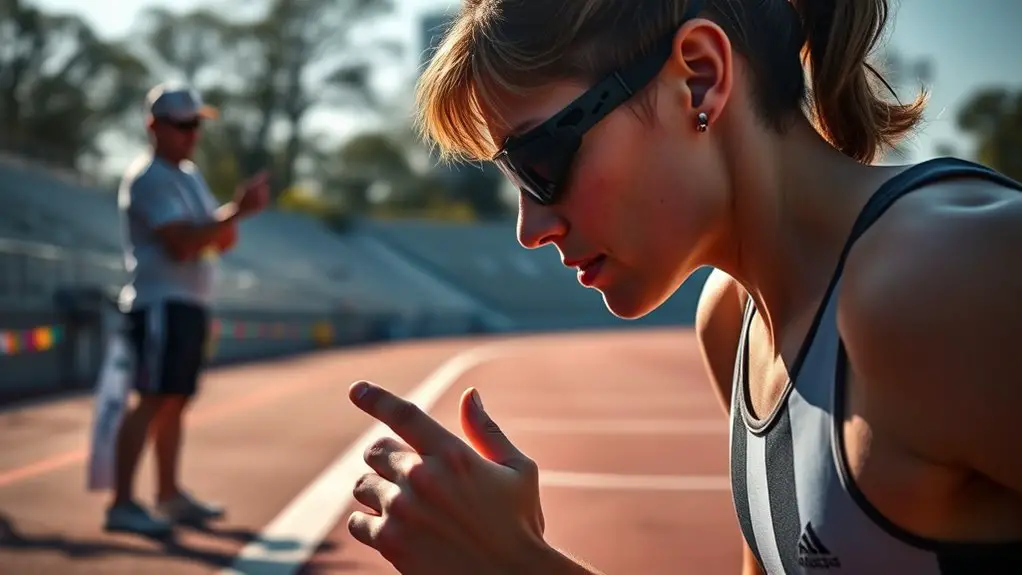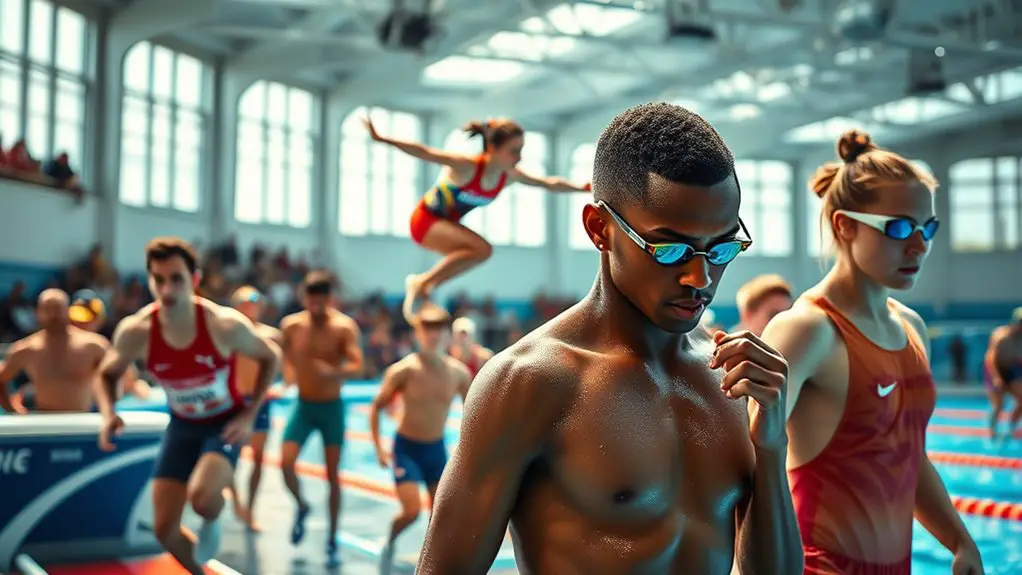The Olympics have transformed athletic performance science in numerous ways. They've spurred advancements in training methods, nutrition, injury recovery, and psychological techniques. You'll see how technology enhances training and how nutrition fuels elite athletes. By prioritizing mental resilience and inclusivity, the Games encourage innovative strategies for all athletes. Their influence drives continuous evolution in performance science. If you're curious about specific breakthroughs and their impact, there's much more to explore.
The Historical Origins of Olympic Performance Science
When you explore the origins of Olympic performance science, you'll find that it dates back to the ancient Greeks, who valued physical excellence and sought ways to enhance athletic ability. Ancient competitions weren't just about winning; they were a celebration of athlete dedication and a reflection of cultural influences. The Greeks developed training philosophies that emphasized rigorous physical education, blending ritualistic practices with early advancements in understanding the human body. This commitment to improvement fostered a competitive spirit that still resonates today. As athletes pushed their limits, they laid the groundwork for what we now recognize as performance science. Their insights into nutrition, conditioning, and mental preparation paved the way for future generations. By studying their methods, you can appreciate how the quest for freedom in athletic expression began, igniting a passion that continues to inspire athletes around the world. The legacy of these ancient practices is a tribute to the enduring pursuit of excellence. Additionally, their early understanding of hydration strategies for athletes highlighted the importance of maintaining proper fluid levels for optimal performance and recovery.
The Role of Technology in Training and Equipment
As athletes endeavor for peak performance, technology plays a crucial role in revolutionizing training and equipment. Wearable technology, like fitness trackers and heart rate monitors, gives you real-time insights into your performance, helping you tailor your training effectively. Advanced materials in clothing and gear enhance your comfort and aerodynamics, allowing you to push boundaries without being weighed down. Smart equipment, such as connected bikes and weight machines, can adapt to your progress, ensuring you're always challenged. Virtual training platforms offer you the flexibility to train anywhere, connecting you with coaches and peers worldwide. This fusion of innovation and freedom transforms how you approach your sport, empowering you to maximize your potential. With these technological advancements, you can break through limits and redefine what's possible in your athletic journey. Embrace these tools, and you'll find yourself not just competing but thriving. Additionally, the integration of real-time heart rate monitoring helps athletes make informed training decisions while optimizing their performance.
Nutrition Breakthroughs Driven by Olympic Athletes
While many factors contribute to an athlete's success, nutrition has emerged as a pivotal element in optimizing performance, particularly among Olympic competitors. You might not realize how much of an impact athlete diets have on their training and competition results. With the pressure to excel at the highest level, many Olympians have turned to nutritional supplements to gain an edge. These supplements can enhance energy levels, improve recovery, and support overall health, allowing athletes to push their limits.
Moreover, the emphasis on tailored diets has sparked innovations in food science. Athletes are now more aware of what fuels their bodies, leading to personalized meal plans that align with their specific needs. This shift in understanding nutrition has reshaped how all athletes, not just Olympians, approach their diets. Embracing these breakthroughs can help you reach your own personal best, whether you're a weekend warrior or aspiring competitor. Creatine supplementation is one such strategy that many athletes utilize to boost strength and power during their training.
The Science of Recovery: Innovations From the Olympic Games
Recovery has become a critical focus in the domain of athletic performance, particularly in the high-stakes environment of the Olympic Games. Athletes now embrace active recovery and sleep optimization as key components of their training regimens. With technology integration, performance tracking has never been more effective, allowing personalized recovery timelines and adaptive strategies for each athlete.
Here's a glimpse of innovative recovery modalities:
| Recovery Modalities | Benefits |
|---|---|
| Active Recovery | Enhances blood flow |
| Sleep Optimization | Boosts mental resilience |
| Injury Rehabilitation | Speeds up muscle recovery |
The Olympics have pushed the envelope on holistic wellness, demonstrating that recovery is as essential as training. Athletes are now equipped with tools and strategies that allow them to recover effectively, ensuring they're ready to perform at their best when it matters most. Incorporating rest days into their training is crucial for enhancing performance and preventing burnout.
Psychological Techniques for Peak Performance
To reach your peak performance, mastering psychological techniques is key. You can harness mental imagery training, develop stress management strategies, and implement effective goal-setting techniques. These tools not only enhance your focus but also boost your confidence when it matters most. Additionally, practicing mindfulness and relaxation techniques can help manage anxiety, creating space for freedom and joy.
Mental Imagery Training
Mental imagery training can be a game-changer for athletes aiming to reach peak performance. By using visualization techniques, you can mentally rehearse your movements, enhancing your skills without physical strain. Imagine executing your sport perfectly—this cognitive rehearsal not only boosts confidence but also prepares your mind for competition. Whether it's picturing a flawless sprint or envisioning a winning jump, these mental exercises help embed the desired actions into your muscle memory. Plus, they create a sense of freedom, letting you explore your potential without the limitations of physical practice. Embrace mental imagery as a powerful tool in your training arsenal, allowing you to push boundaries and achieve greatness in your sport.
Stress Management Strategies
While competing at high levels, athletes often face immense pressure that can hinder performance. To thrive, you need effective stress management strategies. Mindfulness techniques can help ground you in the moment, reducing performance anxiety. Utilize relaxation exercises to calm your mind and body, allowing for emotional regulation. Incorporating visualization practices can also enhance your focus, helping you picture success and navigate challenges. Resilience training builds your ability to bounce back from setbacks, while focus strategies keep your mind sharp under pressure. Explore various coping mechanisms to find what resonates with you, empowering you to perform at your best. Remember, mastering these psychological techniques can free you from constraints, releasing your true athletic potential.
Goal Setting Techniques
Goal setting is a crucial aspect of athletic performance, as it not only provides direction but also fuels motivation. By establishing clear goals, you can channel your energy effectively. Here are three powerful techniques to enhance your goal-setting process:
- Goal Visualization: Picture yourself achieving your goals. This mental imagery can boost your confidence and focus.
- Set Performance Benchmarks: Break your goals into smaller, measurable milestones. These benchmarks help you track progress and celebrate achievements along the way.
- Stay Flexible: Life throws curveballs, so be ready to adjust your goals. Embracing change keeps you motivated and aligned with your true desires.
Incorporating these techniques into your routine can elevate your performance and help you access your full potential.
The Impact of Data Analytics on Athletic Training
Data analytics is transforming how you approach athletic training by providing enhanced performance metrics tailored to your needs. With these insights, you can implement injury prevention strategies and create personalized training programs that optimize your potential. This data-driven approach not only boosts your performance but also keeps you healthier and more focused on your goals. Additionally, real-time analytics enable coaches and athletes to make immediate adjustments to training regimens for continuous improvement.
Enhanced Performance Metrics
As athletes endeavor to reach peak performance, the integration of data analytics in training regimens has become essential. By leveraging data-driven insights, you can not only track your progress but also enhance your training effectiveness. Here are three ways enhanced performance metrics can benefit you:
- Setting Performance Benchmarks: Establish clear goals based on data, helping you understand where you stand compared to others or your previous self.
- Tailoring Training Plans: Use analytics to customize your workouts, maximizing strengths while addressing weaknesses.
- Monitoring Progress in Real-Time: Implement wearable tech to gain instant feedback, allowing for adjustments that can lead to breakthroughs.
Embracing these metrics gives you the freedom to train smarter, not just harder, releasing your full potential.
Injury Prevention Strategies
While pushing your limits is essential for success, preventing injuries is equally important to maintain long-term performance. By leveraging data analytics, you can identify potential risk factors and implement effective preventative measures. Monitoring your training loads and recovery patterns helps pinpoint stress points before they lead to injuries. Embracing innovative rehabilitation techniques, like targeted strength training and mobility exercises, can keep you in top shape when setbacks occur. Regularly analyzing your performance data not only keeps your body safe but empowers you to push boundaries confidently. Remember, staying injury-free allows you to enjoy the freedom of training and competing without unnecessary downtime. Prioritizing these strategies is key to sustaining your passion for sport while achieving your athletic goals.
Personalized Training Programs
When athletes tailor their training programs to fit their unique needs, they access the potential for improved performance and efficiency. By leveraging data analytics, you can create individualized assessments that guide your path to greatness. Here are three key benefits of personalized training:
- Targeted Workouts: Focus on specific areas that need improvement, ensuring your efforts yield the best results.
- Adaptive Coaching: Adjust your training in real-time based on performance data, keeping you in tune with your body's needs.
- Enhanced Recovery: Identify ideal rest periods tailored to your individual recovery rate, preventing burnout and injuries.
With these strategies, you can break free from one-size-fits-all programs, releasing your full athletic potential. Embrace the freedom of personalized training!
Biomechanics: Understanding Movement for Improved Performance
Understanding biomechanics is essential for athletes aiming to enhance their performance, since it involves analyzing the mechanics of movement in sports. By utilizing kinematic analysis and force measurement, you can identify movement patterns that lead to performance optimization. Tools like motion capture and gait analysis allow you to assess athletic biomechanics and develop sport-specific techniques. Incorporating principles from Functional Movement Screening into your training regimen helps you refine your skills and performance.
Here's a quick overview of biomechanics in athletics:
| Aspect | Technique | Purpose |
|---|---|---|
| Kinematic Analysis | Motion Capture | Analyze movement patterns |
| Force Measurement | Strength Assessment | Measure physical forces |
| Injury Mechanics | Gait Analysis | Prevent and understand injuries |
Embracing the freedom of movement with a scientific approach can elevate your game to new heights.
Gender and Inclusivity in Olympic Sports Science
When we talk about gender and inclusivity in Olympic sports science, it's essential to take into account how gender equality initiatives shape the landscape of athletics. You'll see that inclusive training practices and diverse representation in research can greatly influence performance and participation. Let's explore how these elements come together to create a more equitable environment for all athletes.
Gender Equality Initiatives
As the Olympic movement evolves, it's increasingly clear that gender equality initiatives are essential for fostering inclusivity in sports science. These initiatives not only promote fairness but also enhance athletic performance across genders. As you explore the impact of these efforts, consider the following:
- Equity Initiatives: Programs that guarantee equal access to training and resources for all athletes.
- Policy Advancements: New regulations aimed at eliminating gender bias in sponsorship and funding.
- Research Support: Increased funding for studies focused on women's health and performance in sports.
Embracing these changes helps create a level playing field, allowing every athlete the freedom to excel. By championing gender equality, you're supporting a future where all athletes can thrive, regardless of gender.
Inclusive Training Practices
Inclusive training practices are essential for maximizing every athlete's potential, regardless of gender. By embracing adaptive coaching techniques, you can create a supportive environment for all athletes. This means recognizing and celebrating diversity, which enhances athlete engagement. Here's a quick look at some effective practices:
| Practice | Benefits |
|---|---|
| Adaptive Coaching | Tailors training to individual needs |
| Diverse Athlete Engagement | Promotes a sense of belonging |
| Cross-Disciplinary Training | Encourages knowledge sharing |
Implementing these methods not only fosters inclusivity but also cultivates a culture where every athlete feels empowered. Together, we can break down barriers and elevate performance in Olympic sports, ensuring everyone has a chance to shine on the world stage.
Representation in Research
While the significance of gender and inclusivity in Olympic sports science is widely acknowledged, representation in research still lags behind. It's essential to advocate for diversity in research and equitable funding to foster a more inclusive environment. Here are some key points to reflect on:
- Underrepresentation of Women: Many studies focus mainly on male athletes, limiting our understanding of female performance.
- Funding Disparities: Women's sports and research often receive less funding, hampering progress in developing training methods for all athletes.
- Inclusive Research Practices: Encouraging diverse teams in research can lead to innovative solutions tailored for all athletes, regardless of gender.
Case Studies: Athletes Who Changed the Game
Throughout the history of the Olympics, certain athletes have not only excelled in their respective sports but have also revolutionized how we perceive athletic performance. Think of legendary athletes like Michael Phelps and Usain Bolt; their groundbreaking performances set new performance benchmarks that inspired a generation. Phelps' revolutionary techniques in swimming transformed training methods, while Bolt's explosive speed redefined sprinting. These game changers didn't just compete; they created iconic moments that pushed the boundaries of what's possible. Their athletic innovation sparked a sport evolution, encouraging others to break free from traditional limits. You can see how these athletes shaped not just their disciplines but the entire landscape of athletic performance science. By embracing change and pushing against the status quo, they've left an indelible mark, proving that with determination and creativity, anything is achievable in the quest for excellence. Moreover, their ability to thrive under pressure exemplifies the importance of mental toughness, which has become a key focus in performance training.
The Future of Athletic Performance Science Beyond the Olympics
As the world of athletic performance science continues to evolve, the lessons learned from the Olympics are just the beginning. You can expect to see exciting future trends that push boundaries and embrace new ideas. Here are three key areas to watch:
- Global Collaboration: Countries will work together, sharing techniques and knowledge to elevate performance worldwide.
- Grassroots Innovation: Local programs will play a significant role in youth development, ensuring that talent is nurtured from the ground up.
- Interdisciplinary Approaches: By merging fields like psychology, nutrition, and biomechanics, we can enhance athlete performance while considering ethical considerations and cultural influences. Additionally, the integration of AI-driven personalized recovery programs will revolutionize how athletes approach training and rehabilitation.
As we look ahead, sustainability practices will also be essential. You'll witness a movement toward environmentally-friendly training methods and facilities, aligning athletic goals with the planet's well-being. Embrace this exciting future and be part of the change!
Frequently Asked Questions
How Do Olympic Sports Influence Youth Athletic Programs Globally?
Olympic sports inspire youth athletic programs worldwide by promoting youth engagement and global outreach. When you see athletes achieving greatness on such a stage, it motivates young people to pursue their own athletic dreams. These programs often emphasize inclusivity, helping kids from diverse backgrounds connect through sport. The excitement and camaraderie fostered in these environments encourage personal growth and teamwork, allowing youth to experience freedom and passion in their athletic journeys.
What Role Do Mental Health Initiatives Play in Olympic Athlete Performance?
Mental health initiatives are essential for Olympic athletes, as they help you build mental resilience and provide emotional support. When you feel mentally strong, your performance can soar, allowing you to compete at your best. These initiatives create an environment where you can openly discuss challenges, reducing stigma and promoting well-being. With the right support, you can focus on your goals while maintaining a healthy mind, which is just as important as physical training.
How Are Injury Prevention Strategies Developed for Olympic Athletes?
When developing injury prevention strategies for Olympic athletes, you'll focus on thorough injury assessments to identify risk factors. By analyzing past injuries and performance data, you can tailor rehabilitation techniques that enhance recovery and minimize future risks. Incorporating strength training and flexibility exercises into their routines also helps. It's all about creating a holistic approach that allows athletes to perform at their best while enjoying the freedom to compete without fear of injury.
How Do Cultural Differences Impact Training Methods in Olympic Sports?
Imagine a samurai training for battle, blending ancient tradition with modern techniques. Cultural differences greatly impact training methods in Olympic sports. You'll find that traditional techniques often shape the foundation of training, while cultural philosophies influence performance expectations. Countries adapt their training regimens to reflect these values, leading to unique training adaptations. Embracing this diversity can enhance your understanding of how athletes reach their peak and thrive on the world stage.
What Ethical Considerations Arise in Olympic Performance Science Research?
When diving into Olympic performance science research, you'll face several ethical considerations. Informed consent is essential; athletes must understand how their data will be used. Data privacy can't be overlooked, as personal information should remain confidential. Additionally, adhering to ethical guidelines guarantees that research doesn't promote unsafe performance enhancement methods. Balancing the pursuit of excellence with respect for individual rights keeps the spirit of sports alive, allowing athletes to thrive without compromising their integrity.




